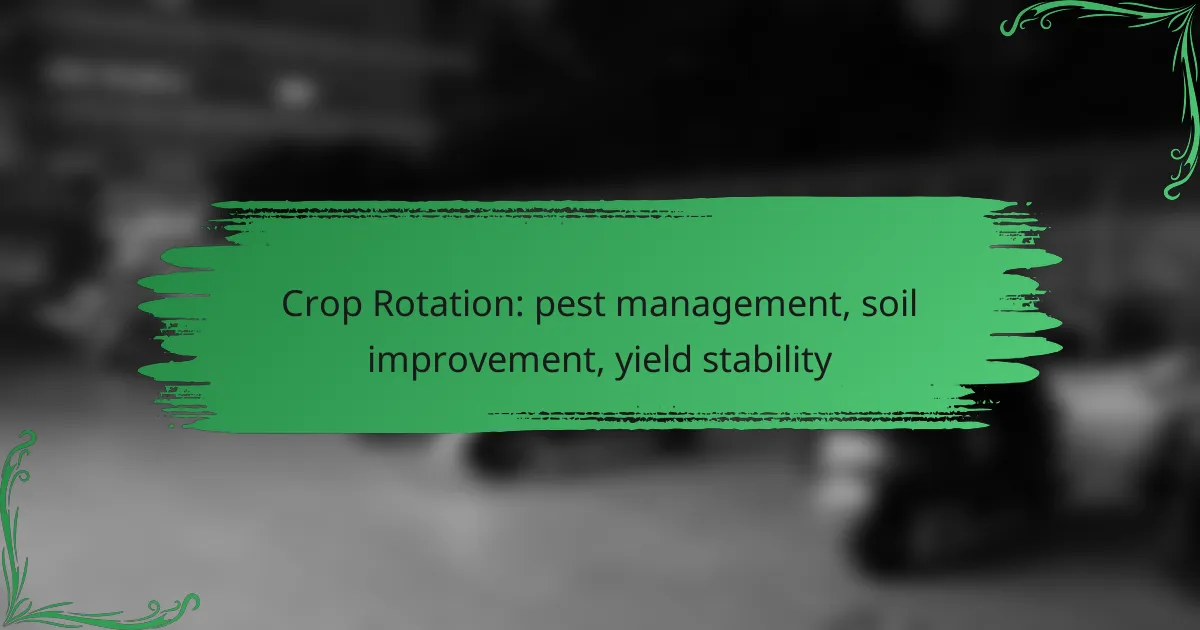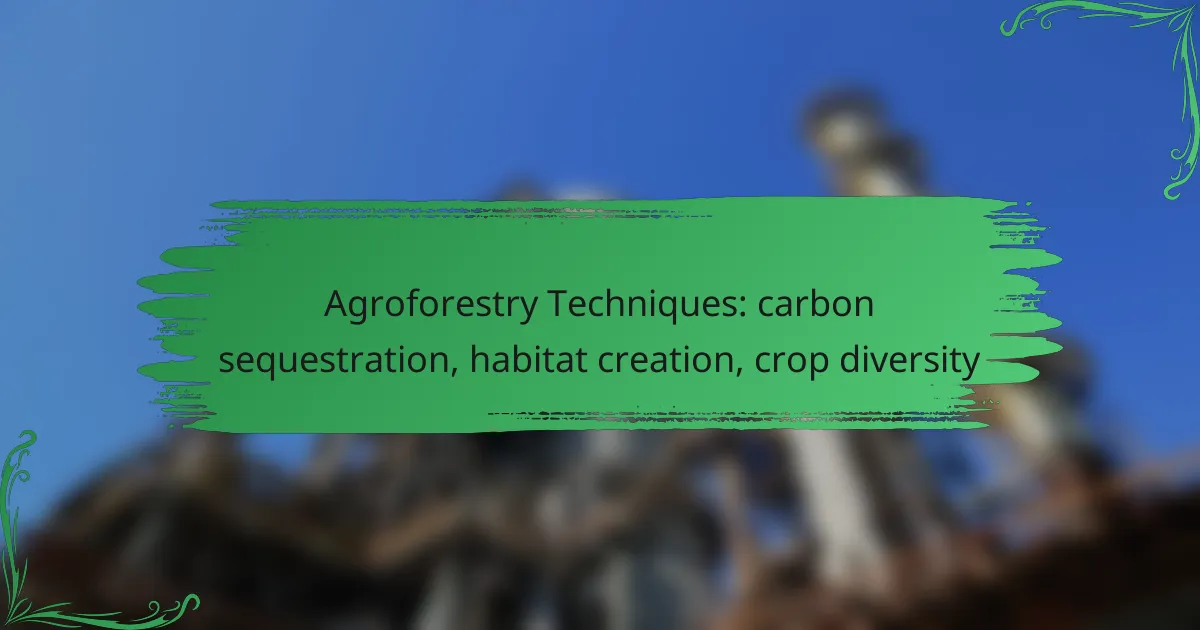Vertical farming revolutionizes urban agriculture by maximizing space efficiency through multi-layered growing systems, allowing for substantial crop production in limited areas. This innovative method ensures year-round availability of fresh produce, catering to the needs of densely populated cities while minimizing transportation costs and environmental impact.
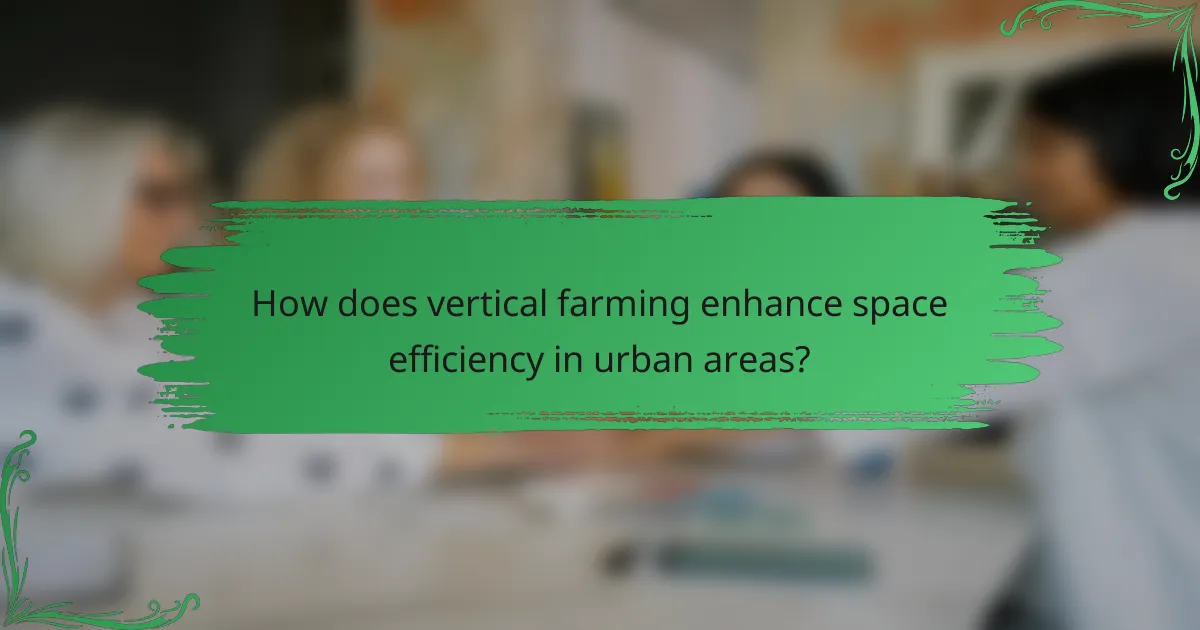
How does vertical farming enhance space efficiency in urban areas?
Vertical farming significantly enhances space efficiency in urban areas by utilizing multi-layered growing systems that maximize crop production in limited spaces. This innovative approach allows for the cultivation of a large volume of crops in a relatively small footprint, making it ideal for densely populated cities.
Maximized crop yield per square meter
Vertical farming can produce yields that are several times greater than traditional farming methods within the same area. By stacking layers of crops, farmers can optimize light exposure and resource use, leading to higher productivity. For example, some vertical farms report yields of up to 10 times more per square meter compared to conventional agriculture.
This increased yield is particularly beneficial in urban settings where land is scarce and expensive. By maximizing crop output, vertical farms can help meet the food demands of growing urban populations.
Utilization of hydroponics and aeroponics
Vertical farms often employ hydroponics and aeroponics, which are soil-less growing techniques that further enhance space efficiency. Hydroponics uses nutrient-rich water solutions to grow plants, while aeroponics involves misting the roots with nutrients, allowing for faster growth and reduced space requirements.
These methods not only save space but also reduce water usage by up to 90% compared to traditional farming. This is crucial in urban areas where water conservation is increasingly important.
Integration into existing urban infrastructure
Vertical farms can be seamlessly integrated into existing urban infrastructure, such as rooftops, warehouses, and even abandoned buildings. This integration allows cities to utilize underused spaces for food production, reducing the need for additional land and transportation costs associated with traditional agriculture.
By transforming urban spaces into productive farms, cities can enhance local food security and reduce their carbon footprint. This approach aligns with sustainable urban development goals and can contribute to healthier urban environments.
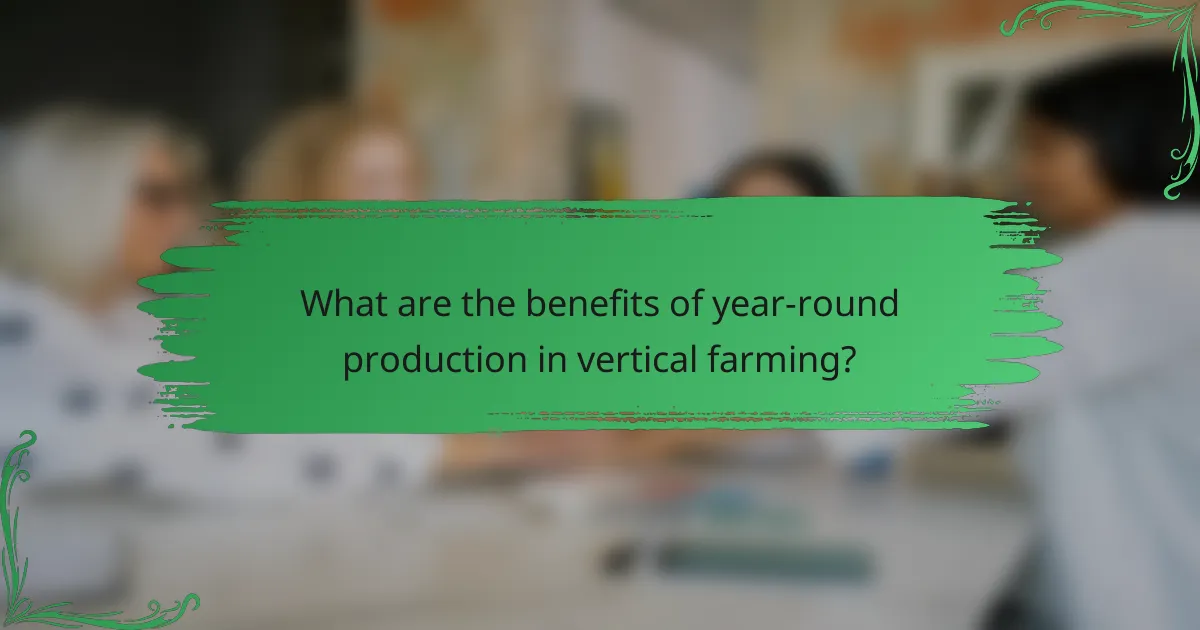
What are the benefits of year-round production in vertical farming?
Year-round production in vertical farming ensures a continuous supply of fresh produce, regardless of external weather conditions. This approach maximizes space efficiency and allows urban agriculture to thrive, providing fresh food to local communities throughout the year.
Consistent supply of fresh produce
Vertical farming enables a steady output of fresh fruits and vegetables, which is crucial for meeting consumer demand. By utilizing controlled environments, crops can be grown independently of seasonal changes, ensuring that produce is available at any time. This consistency helps retailers maintain stock and reduces the risk of shortages.
For example, leafy greens can be harvested multiple times a year, providing a reliable source of nutrition for urban populations. This constant availability supports local diets and can lead to healthier eating habits.
Reduction in seasonal crop dependency
With vertical farming, the reliance on seasonal crops is significantly diminished. Growers can cultivate a variety of crops year-round, which diversifies the agricultural output and reduces the risks associated with seasonal fluctuations. This adaptability allows farmers to respond to market demands more effectively.
For instance, instead of waiting for specific harvest seasons, farmers can plant and harvest crops like tomatoes or herbs throughout the year, ensuring that they can cater to consumer preferences without interruption.
Lower transportation costs
Year-round production in vertical farms located near urban centers can lead to reduced transportation costs. By growing food closer to where it is consumed, the need for long-distance shipping is minimized, which not only cuts costs but also lowers carbon emissions associated with transport.
Additionally, local sourcing of produce can lead to fresher options for consumers, as food does not spend extended periods in transit. This can enhance the overall quality of the produce available in urban markets.
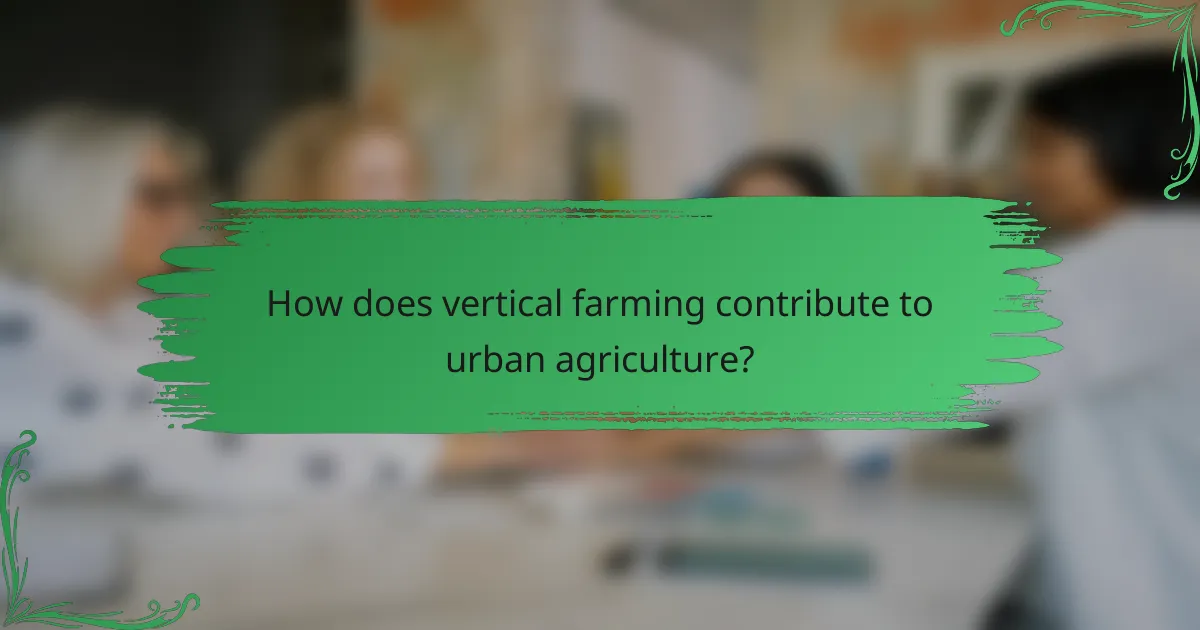
How does vertical farming contribute to urban agriculture?
Vertical farming enhances urban agriculture by maximizing space efficiency and enabling year-round crop production. This innovative approach allows cities to grow food locally, reducing transportation costs and carbon footprints while providing fresh produce to urban populations.
Local food production
Vertical farming systems can be established in urban areas, utilizing rooftops, warehouses, and other underused spaces. By growing food closer to consumers, cities can ensure a steady supply of fresh produce, which is particularly beneficial in densely populated regions where traditional agriculture is impractical.
These farms often employ hydroponics or aeroponics, which require less water and land compared to conventional farming methods. For instance, a vertical farm can produce the same yield as several acres of traditional farmland, making it a highly efficient option for urban settings.
Reduction of food deserts
Food deserts are urban areas with limited access to affordable and nutritious food. Vertical farming can play a crucial role in alleviating this issue by providing fresh fruits and vegetables directly within these communities. By establishing farms in food deserts, cities can improve food security and promote healthier eating habits.
Moreover, vertical farms can operate in areas where soil quality is poor or contaminated, ensuring that residents have access to safe and healthy food options. This accessibility can lead to improved public health outcomes and reduced reliance on processed foods.
Community engagement and education
Vertical farming initiatives often involve local communities, fostering engagement through workshops, tours, and volunteer opportunities. These programs can educate residents about sustainable practices, nutrition, and the benefits of local food systems.
By involving schools and community groups, vertical farms can inspire the next generation to take an interest in agriculture and sustainability. This hands-on experience can help cultivate a sense of ownership and responsibility towards local food production, ultimately strengthening community ties.
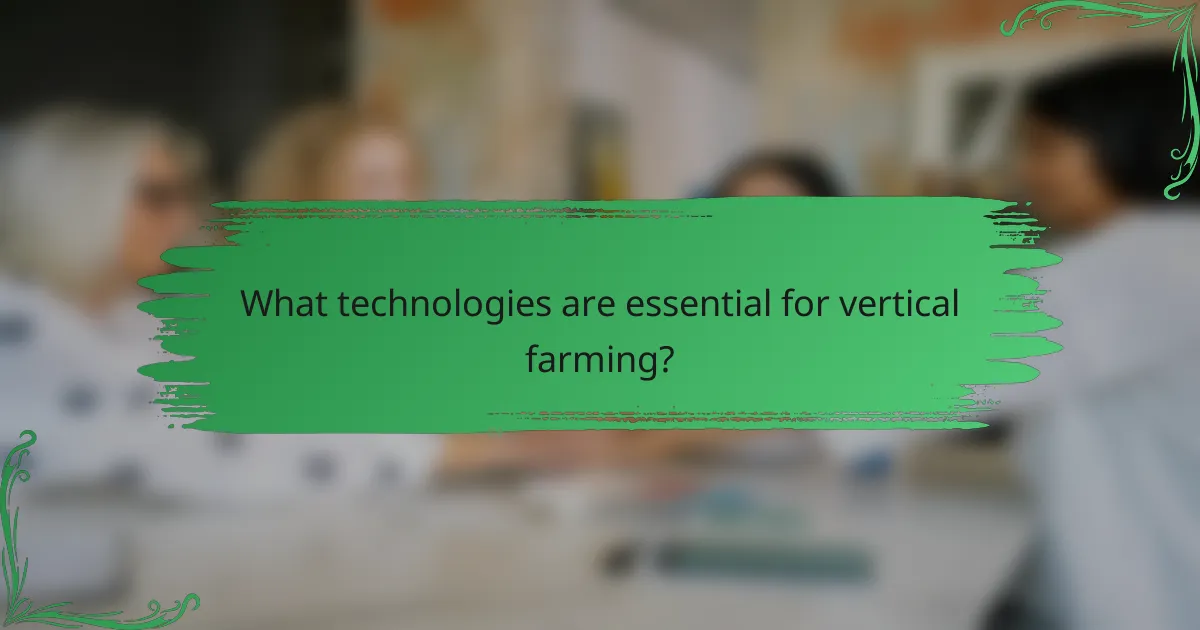
What technologies are essential for vertical farming?
Essential technologies for vertical farming include advanced LED lighting systems, climate control technologies, and automated nutrient delivery systems. These innovations enable efficient use of space, optimize growing conditions, and ensure consistent crop production throughout the year.
LED lighting systems
LED lighting systems are crucial in vertical farming as they provide the specific light spectrum needed for plant growth while consuming less energy than traditional lighting. These systems can be tailored to different growth stages, enhancing photosynthesis and improving yields.
When selecting LED lights, consider factors such as light intensity, spectrum, and energy efficiency. High-quality LEDs can reduce energy costs by up to 50% compared to older technologies, making them a cost-effective choice for urban farms.
Climate control technologies
Climate control technologies regulate temperature, humidity, and air circulation, creating optimal growing environments for crops. These systems often include sensors and automated controls to maintain ideal conditions, which can significantly enhance plant health and productivity.
Investing in climate control can lead to better resource management, reducing water usage and energy costs. For instance, maintaining a stable temperature range of 20-25°C can improve growth rates for many leafy greens.
Automated nutrient delivery systems
Automated nutrient delivery systems ensure that plants receive the right amount of nutrients at the right time, which is essential for maximizing growth in vertical farming. These systems can be integrated with hydroponic or aeroponic setups, allowing for precise control over nutrient concentrations.
When implementing these systems, consider using sensors to monitor nutrient levels and adjust accordingly. This can help prevent common issues such as nutrient deficiencies or toxicities, ultimately leading to healthier crops and higher yields.

What are the economic considerations for starting a vertical farm?
Starting a vertical farm involves various economic factors that can significantly impact its viability. Key considerations include initial investment costs, ongoing operational expenses, and the potential return on investment.
Initial investment costs
The initial investment for a vertical farm can vary widely based on scale and technology. Costs typically range from tens of thousands to several million dollars, depending on factors like location, equipment, and infrastructure. Essential expenditures include land acquisition or leasing, building construction, and purchasing systems for lighting, irrigation, and climate control.
It’s crucial to conduct a thorough cost analysis before starting. Consider not only the direct costs but also any permits or regulatory fees that may apply in your area. For example, urban locations may have higher land costs but could offer better access to markets.
Operational expenses
Operational expenses for vertical farming include utilities, labor, maintenance, and supplies. Energy costs can be significant due to the need for artificial lighting and climate control, often accounting for a large portion of monthly expenses. Labor costs may also be higher if specialized skills are required for managing advanced technologies.
Regular maintenance of equipment and systems is essential to ensure optimal production. Budgeting for these ongoing costs is vital to maintain profitability. Consider implementing energy-efficient technologies to help reduce utility expenses over time.
Potential return on investment
The potential return on investment (ROI) for vertical farming can be attractive, particularly in urban areas with high demand for fresh produce. While payback periods can vary, many farms aim for a ROI within three to five years. Factors influencing ROI include crop yield, market prices, and operational efficiency.
To maximize ROI, focus on high-value crops that can be sold at premium prices, such as herbs or specialty greens. Establishing direct sales channels, like farmers’ markets or local restaurants, can also enhance profitability. Regularly reviewing and adjusting your business model based on market trends will help sustain financial health.
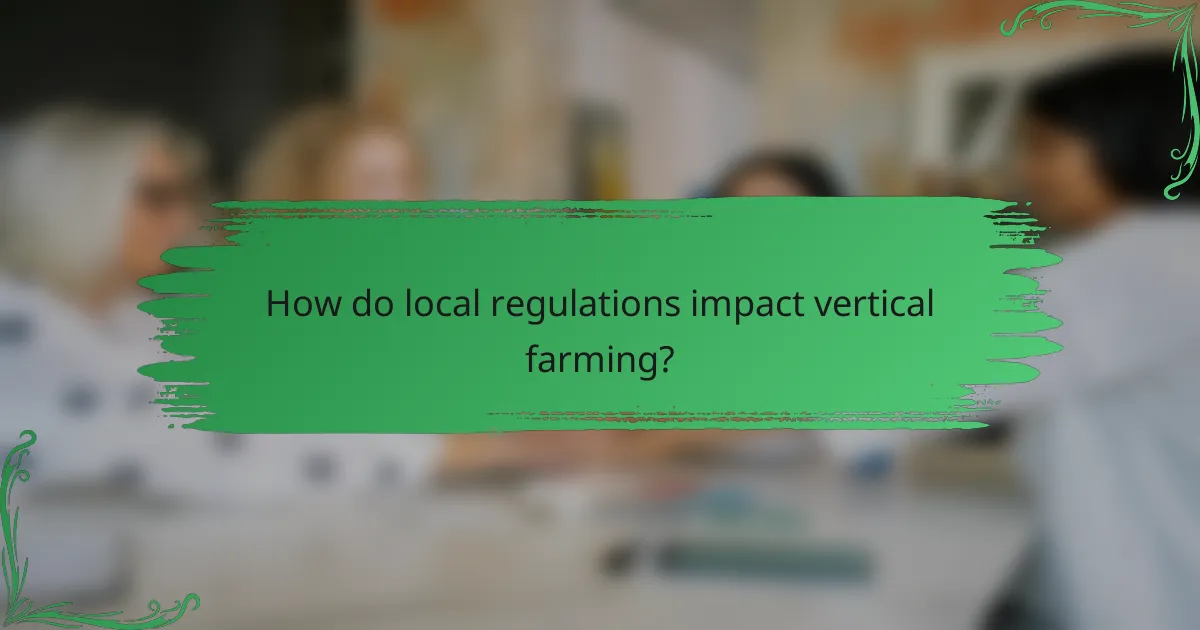
How do local regulations impact vertical farming?
Local regulations significantly influence vertical farming by dictating where and how these farms can operate. Compliance with zoning laws, health and safety standards, and available incentives can determine the feasibility and profitability of urban agriculture initiatives.
Zoning laws and land use
Zoning laws are critical for vertical farming as they define the types of activities permitted in specific areas. Many urban areas have designated zones for agricultural use, which may include restrictions on building heights, land coverage, and proximity to residential areas. Understanding these regulations is essential for securing the necessary permits and ensuring that the farm can operate legally.
For instance, some cities may allow vertical farms in industrial zones but prohibit them in residential neighborhoods. Farmers should consult local zoning ordinances to identify suitable locations and avoid potential legal issues.
Health and safety regulations
Health and safety regulations govern the operational standards of vertical farms, ensuring that food produced is safe for consumption. These regulations may cover aspects such as water quality, pesticide use, and sanitation practices. Adhering to these standards is crucial for gaining consumer trust and meeting market demands.
Vertical farmers should familiarize themselves with local health codes, which can vary significantly. For example, some regions may require regular inspections or specific certifications for food safety, impacting operational costs and timelines.
Incentives for urban agriculture
Many local governments offer incentives to promote urban agriculture, including grants, tax breaks, and low-interest loans. These incentives can help offset startup costs and encourage investment in vertical farming projects. Understanding available programs can provide financial advantages and enhance project viability.
Farmers should research local agricultural programs and engage with community organizations that support urban farming initiatives. This proactive approach can lead to valuable resources and partnerships that strengthen the business model and sustainability of vertical farms.

